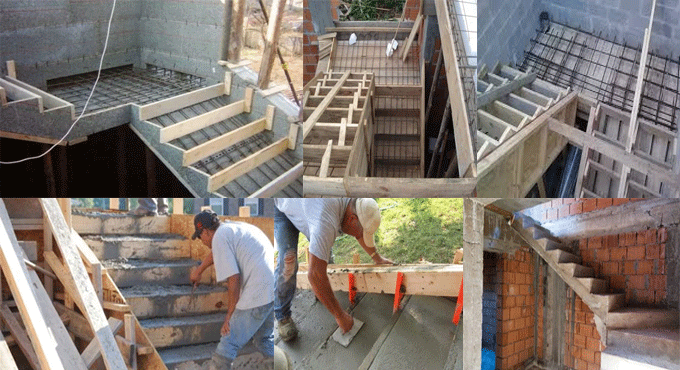
Construction method for concrete stairs
Construction of concrete stairs involve various steps like designing, developing foundation, formwork erection, placing of reinforcement steel bars, concreting, finishing and curing.
Given below, the details steps for building a concrete stairs from outset.
1. Create the design of Concrete Stairs: Design aspects and site study are two most vital features of design. To make the perfect design of stairs, various factors like height of the floor, width of the stairs, risers depth, thread width, thickness of the stairs, angle of the stairs, load employed on the stairs and several other aspects should be taken into consideration.
2. Foundation and Support for Concrete Stairs: In order to transmit the loads of the stairs into ground properly as well as withstand the movement of stairs, the foundation of concrete stairs should be made perfectly.
If the plinth beam of building exists at the start of the stairs, then the reinforcement steels bars are affixed to them to transmit the loads successfully. If there is no plinth beam, then a small concrete foundation or size stone masonry is built up.
The support is provided to the stairs at the top that controls the movement of stairs. It is normally given to the roof beam or slab.
3. Developing the Form-work for Concrete Stairs: A perfect formwork should be utilized at the time of erecting concrete stairs. The proper inspection should be made to the angle of flight, dimensions of thread and riser. Normally, at the time of erecting a stairs connected to wall, the line of flight, thread and risers are marked on the wall for proper fixing of shuttering or formwork.
The boards should be minimum 2? thick to provide support to the weight of the concrete. The entire structure of the form, should be supported with 4?4 posts. The wooden boards are applied to develop the steps and these are attached with various screws to the lateral structure of the formwork.
4. Steel Reinforcement for Concrete Stairs: The concrete steps should be reinforced with steel bars in order to bear the loads enforced on the stairs and transmit them to the ground. The number of steel bars and size of the bars should be measured by a structural engineers based on the loads enforced on the stairs.
These steel reinforcement bars are provided in the formwork with minimum of 25 mm spacing and are attached together.
5. Pouring of Concrete for Concrete Stairs: Pouring of concrete into the formworks is commenced from the below part to above. The strength and stability of stairs is maintained by the concrete mix. Standard mix for stairs is made with 3 parts cement, 2 parts sand, 4 parts gravel and water.
A concrete vibrator should be applied at the time of pouring the concrete to entirely fill the gaps of the stairs as well as get rid of the honeycomb development.
It should be done carefully since any abrupt movements can create trouble in aligning the formworks or even collapsing the formwork. It should be kept in mind that the concrete ceiling and stairs should be poured in the same day with the purpose of making a strong bond among these components.
6. Removal of Formwork: The stairs need minimum 21 days to dry out totally, so the removal of formwork should be done only after 21days. In these 21 days, proper curing should be accomplished to resist the cracks in stairs because of thermal expansion.
After the 21 days, the formwork should be eliminated through a hammer and a crowbar. Here, precautions should be taken so that no damage can occur to the concrete or the edges of the stairs.
7. Finishing of Concrete Stairs: As soon as the formwork is detached, the stairs can be finished in different ways according to the need of the use. It can either be finished with trowel or float to provide concrete finish, cement tiles, granite set up for better look. Even carpet or wood can also be applied to finish the stairs.


